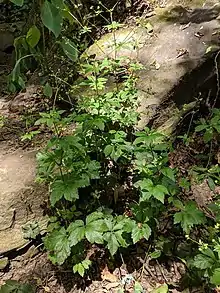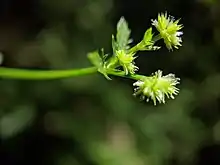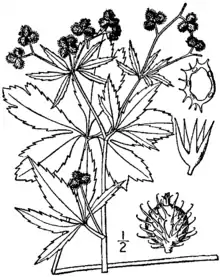Sanicula canadensis
Sanicula canadensis, the Canadian blacksnakeroot,[2] is a native plant of North America and a member of family Apiaceae. It is biennial or perennial, and spreads primarily by seed.[3] It grows from 1 to 4.5 feet tall, and is found in mesic deciduous woodlands.[3] The whitish-green flowers with sepals longer than petals, appearing late spring or early summer and lasting for approximately three weeks, are green and bur-like.[3][4] The bur-like fruit each split into 2 seeds.[3][4] The species ranges throughout the eastern United States (excluding Maine), extending north into Quebec and Ontario, and west into Texas and Wyoming.

Plant with flowers

Flowers
| Sanicula canadensis | |
|---|---|
 | |
| 1913 illustration[1] | |
| Scientific classification | |
| Kingdom: | |
| (unranked): | |
| (unranked): | |
| (unranked): | |
| Order: | |
| Family: | |
| Genus: | |
| Species: | S. canadensis |
| Binomial name | |
| Sanicula canadensis | |
References
- Britton, N.L., and A. Brown. 1913. An illustrated flora of the northern United States, Canada and the British Possessions. 3 vols. Charles Scribner's Sons, New York. Vol. 2: 624.
- "Sanicula canadensis". Natural Resources Conservation Service PLANTS Database. USDA. Retrieved 30 October 2015.
- Hilty, John (2016). "Sanicula canadensis". Illinois Wildflowers.
- "Sanicula canadensis". Flora of Wisconsin. Wisconsin State Herbarium, University of Wisconsin–Madison.
This article is issued from Wikipedia. The text is licensed under Creative Commons - Attribution - Sharealike. Additional terms may apply for the media files.